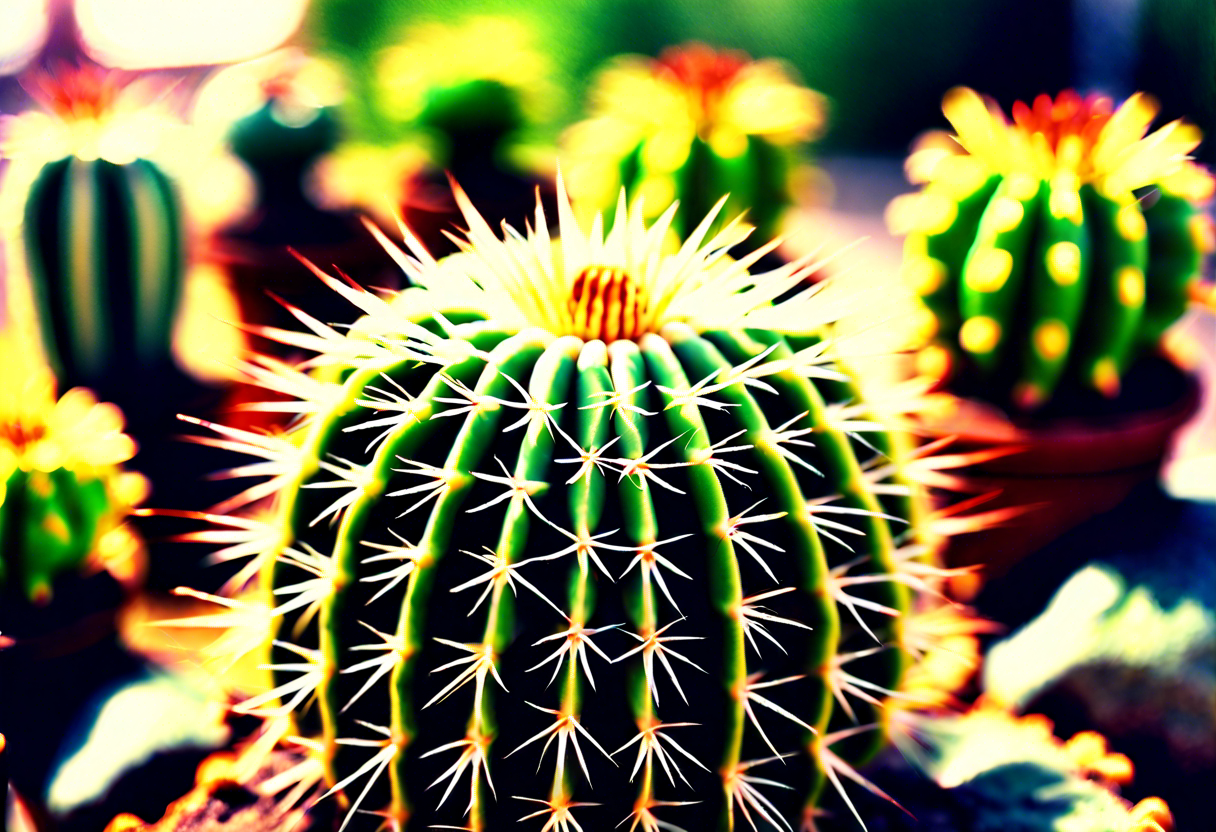The Different Types of Cactus Varieties
When it comes to the world of succulents, cacti are among the most popular and beloved plants. With their unique appearance, low maintenance needs, and ability to thrive in arid environments, it’s no wonder why cacti have gained a devoted following. However, not all cacti are the same. There is a wide variety of species and cultivars, each with its own distinct characteristics and care requirements. In this article, we will explore some of the different types of cactus varieties that you can choose from to add beauty and diversity to your plant collection.
-
Opuntia: Also known as the prickly pear cactus, Opuntia is easily recognizable thanks to its flat, oval pads covered in spines. These pads often feature vibrant colors and can produce striking flowers. Opuntia cacti are known for their ability to thrive in hot, dry climates and require plenty of sunlight to grow.
-
Echinocactus: Commonly referred to as the barrel cactus, Echinocactus is known for its round, cylindrical shape and prominent ribs. These cacti usually have a spiny exterior and can grow to impressive sizes. Barrel cacti are hardy and can tolerate temperature fluctuations, making them suitable for both indoor and outdoor cultivation.
-
Mammillaria: With their small, globular bodies covered in tiny spines, Mammillaria cacti are a popular choice among cactus enthusiasts. These plants often produce vibrant flowers that add a splash of color to any space. Mammillaria prefer bright, indirect light and well-draining soil.
-
Astrophytum: Known as star cacti or sea urchin cacti, Astrophytum species are instantly recognizable due to their unique, star-shaped patterns and lack of sharp spines. Their slow growth rate and compact size make them perfect for small spaces or indoor cultivation.
-
Gymnocalycium: Gymnocalycium cacti, also known as chin cacti, are native to South America. These plants are characterized by their small, round bodies covered in spines and their ability to produce colorful flowers. Gymnocalycium cacti thrive in bright light and well-draining soil.
-
Ferocactus: The genus Ferocactus includes several large cacti species known for their impressive size and spiny appearance. These cacti are drought-tolerant and prefer full sun exposure. Ferocactus varieties make fascinating focal points in gardens or indoor plant collections.
-
Epiphyllum: Unlike most cacti, Epiphyllum species are epiphytic, meaning they grow on other plants instead of in the ground. These hanging or trailing cacti produce stunning, fragrant flowers and can be grown indoors or outdoors in well-draining soil.
These are just a few examples of the diverse range of cactus varieties available to plant enthusiasts. Each type has its own unique beauty and characteristics. Make sure to research and understand the specific care requirements for the cactus varieties you choose, as their needs may vary. Whether you’re a beginner or an experienced collector, there is a cactus variety out there that will capture your heart with its striking appearance and resilience.
Popular Cactus Varieties for Indoors and Outdoors
Cacti are known for their resilience and ability to thrive in arid environments. They come in a wide variety of shapes, sizes, and colors, making them popular choices for both indoor and outdoor gardens. Whether you have a green thumb or are just starting your journey as a plant enthusiast, there is a cactus variety that will suit your preference. Here are some popular cactus varieties that can be grown both indoors and outdoors.
One of the most popular cactus varieties is the Echinocactus grusonii, commonly known as the Golden Barrel Cactus. This cactus features a spherical shape with golden spines, giving it a unique and eye-catching appearance. It is relatively easy to care for and can grow both indoors and outdoors. The Golden Barrel Cactus requires plenty of sunlight and well-draining soil to thrive. Its low maintenance needs make it a favorite amongst beginners.
Another popular cactus variety is the Opuntia ficus-indica, also known as the Prickly Pear Cactus. This cactus is famous for its flat, paddle-shaped stems covered in sharp spines. It produces vibrant, colorful flowers in the spring and edible fruits called prickly pears. The Prickly Pear Cactus is a versatile plant that can be grown in containers or planted directly in the ground. It is drought-tolerant and can withstand a wide range of temperatures, making it suitable for both indoor and outdoor environments.
For those looking for a compact cactus variety that is perfect for indoor cultivation, the Mammillaria gracilis, also known as the Feather Cactus, is an excellent choice. This small, globe-shaped cactus features numerous interlacing white spines that resemble feathers. It does well in bright, indirect light and requires well-draining soil. The Feather Cactus is a great addition to any cactus collection and can be easily propagated through offsets.
If you prefer a cactus variety with a more unique appearance, the Gymnocalycium mihanovichii, also known as the Moon Cactus, is worth considering. This cactus lacks chlorophyll and has bright, vibrant colors ranging from red, orange, pink, and yellow. The Moon Cactus is often grafted onto a stock cactus to provide it with necessary nutrients. It requires bright, indirect light and well-draining soil to thrive. Its striking colors make it a popular choice for indoor gardens and succulent arrangements.
Cacti offer a wide range of options for both indoor and outdoor gardening enthusiasts. Popular cactus varieties such as the Golden Barrel Cactus, Prickly Pear Cactus, Feather Cactus, and Moon Cactus are just a few examples of the diverse selection available. Remember to provide adequate sunlight, well-draining soil, and minimal watering to ensure the health and longevity of your cactus collection. these popular varieties into your garden will surely add a touch of uniqueness and beauty.
Unique and Rare Cactus Varieties for Collectors
When it comes to cacti, there are numerous unique and rare varieties that catch the eye of collectors worldwide. These plants not only add a touch of beauty to any collection but also offer a sense of exclusivity. If you are a cactus enthusiast looking to expand your collection with some extraordinary specimens, here are a few unique and rare cactus varieties that will undoubtedly pique your interest.
-
Euphorbia Obesa: Also known as the Baseball Plant, this cactus variety is native to South Africa. It is named after its peculiar shape, which resembles a ball or a small baseball. The Euphorbia Obesa is renowned for its attractive patterns and has become increasingly popular among collectors due to its unique appearance.
-
Ariocarpus Retusus: The Ariocarpus Retusus, commonly called the Living Rock Cactus, is a rare variety native to Mexico. It gets its name from its remarkable ability to camouflage itself among rocks, making it almost indistinguishable. Its slow growth and highly defined geometric patterns make it a must-have for collectors seeking an exceptional addition to their cactus assortment.
-
Gymnocalycium Mihanovichii: This cactus variety, referred to as the Moon Cactus or Hibotan Cactus, is known for its strikingly colorful and bulbous appearance. It lacks chlorophyll, giving it a unique and vivid range of colors, including bright pinks, oranges, and yellows. The Gymnocalycium Mihanovichii is a popular choice among collectors due to its eye-catching aesthetics.
-
Lophophora Williamsii: Commonly known as Peyote, Lophophora Williamsii is a small, spineless cactus found in the deserts of Mexico and southwestern Texas. It has been used for centuries in religious and spiritual ceremonies by indigenous communities. Due to its slow growth and its controlled distribution due to legal restrictions, Peyote has become highly sought after by collectors intrigued by its cultural significance and scarcity.
-
Echinocactus Grusonii: The Golden Barrel Cactus is a globular species native to Mexico, known for its remarkable golden spines and spherical shape. This slow-growing cactus can reach impressive sizes, making it a popular collector’s choice for both indoor and outdoor cultivation. The Echinocactus Grusonii has gained popularity worldwide for its distinctive appearance and ability to transform any space into a desert oasis.
As a cactus collector, delving into the world of unique and rare cactus varieties can be an exciting and rewarding endeavor. Whether it’s the unusual shapes, vibrant colors, or cultural significance, these specimens offer a distinct charm that sets them apart from more common cactus varieties. By incorporating these exceptional plants into your collection, you will create a visually captivating display that showcases the beauty and diversity of the cactus family.
The Different Types of Cactus Varieties
When it comes to cacti, there is a wide variety of species available, each with its own unique characteristics and requirements. From small and compact varieties suitable for indoor spaces to large and towering species perfect for outdoor gardens, cactus enthusiasts have a plethora of options to choose from. In this article, we will explore the different types of cactus varieties and their distinguishing features.
One popular category of cactus varieties is the desert cacti. As the name suggests, these cacti are native to arid regions and are well adapted to survive in harsh, dry conditions. They typically have thick, spiky stems that store water, enabling them to endure extended periods without rainfall. The iconic Saguaro cactus, with its impressive height and branching arms, is a prime example of a desert cactus variety.
Another common type of cactus is the jungle cacti, which are native to tropical rainforests. Unlike their desert-dwelling counterparts, jungle cacti prefer higher humidity levels and indirect sunlight. These cacti often have slender, trailing stems and beautiful flowers, making them popular choices for hanging baskets and indoor spaces. The Christmas cactus, with its vibrant blooms during the holiday season, is a well-known jungle cactus variety.
For collectors and enthusiasts seeking unique and rare cactus varieties, there are numerous options to explore. Some examples include the Moon cactus, which lacks chlorophyll and features vibrant, colorful tops grafted onto a different cactus species. The Bishop’s Cap cactus, with its distinctive columnar shape and pronounced ribs, is another eye-catching addition to any collection. These rare cacti are highly sought after for their unusual characteristics and the challenges they present in cultivation.
When it comes to caring for different cactus varieties, there are a few essential tips and tricks to keep in mind. First and foremost, proper drainage is crucial for preventing root rot, so it’s essential to use well-draining soil and containers with drainage holes. Cacti also require ample sunlight, so placing them in a sunny window or under grow lights is important. However, it’s essential to acclimate them gradually to avoid sunburn.
Watering is another critical aspect of cactus care. While they are drought-tolerant, cacti still need periodic watering. The frequency will vary based on the season and environmental conditions, but it’s crucial to allow the soil to dry out between waterings to prevent root rot. Additionally, fertilizing during the growing season can provide the necessary nutrients for healthy growth, but it’s vital to use a balanced, diluted fertilizer specifically formulated for cacti.
The world of cactus varieties is incredibly diverse and fascinating. From desert-dwelling giants to delicate jungle species and rare collector’s items, there is a cactus variety to suit every preference. By understanding the specific requirements of each type and providing proper care, cactus enthusiasts can enjoy a thriving and visually appealing collection. So, whether you are a seasoned collector or just starting, explore the diverse world of cactus varieties and create an oasis of unique plants in your own home or garden.
How to Propagate and Multiply Your Cactus Variety Collection
One of the joys of owning cactus plants is having the opportunity to propagate and multiply your collection. Propagation allows you to expand your assortment of cactus varieties by creating new plants from existing ones. Whether you are a seasoned collector or a beginner, learning how to propagate cacti can be a rewarding experience. In this article, we will explore different methods of propagating cacti and provide you with valuable tips to ensure successful propagation.
-
Seeds: One way to propagate cacti is through seeds. Start by collecting ripe seeds from your mature cactus plants. Gently remove them and place them in a container. It is important to use well-draining soil specifically formulated for cacti. Sow the seeds on the surface of the soil and lightly press them down. Water the seeds gently, ensuring that the soil remains moist but not too wet. Place the container in a warm location with plenty of sunlight. With time, you will witness the seeds germinate and grow into new cactus plants.
-
Offsets: Many cactus varieties produce offsets, also known as pups or babies, which can be separated from the parent plant and grown independently. To propagate through offsets, carefully remove them from the main plant using a sharp and sterilized knife. Allow the offsets to dry for a few days, allowing the cut ends to callus over. Once calloused, plant the offsets in a well-draining cactus potting mix. Water sparingly, giving the plants time to establish their root systems. Over time, the offsets will develop into independent cactus plants.
-
Cuttings: Another popular method of propagation is through stem cuttings. Choose a healthy and mature cactus stem, and use a sharp and sterilized knife to cut a section of the stem. Allow the cut end to dry for a few days until a callus forms. Once calloused, plant the cutting in a well-draining cactus mix, burying it about an inch into the soil. Water sparingly, as overwatering can lead to rotting. With time, the cutting will grow roots and develop into a new cactus plant.
When propagating cacti, it is important to provide the right conditions for success. Cacti thrive in well-draining soil and require plenty of sunlight. Avoid overwatering, as excessive moisture can lead to root rot. Instead, water sparingly, allowing the soil to dry out between waterings. Additionally, ensure that the newly propagated plants are protected from extreme temperatures and are gradually acclimated to their new environment.
Propagating cacti is an exciting and rewarding process that allows you to expand your collection and share your love for these unique plants with others. Whether you choose to propagate through seeds, offsets, or cuttings, each method requires care, patience, and attention to detail. By following the tips provided in this article, you can successfully propagate and multiply your cactus variety collection, bringing new life and beauty to your home or garden.
Conclusion
Cactus varieties offer a diverse and fascinating world of plants that are suitable for both indoor and outdoor environments. From small and spiky specimens to large and flowering varieties, there is a cactus to suit every taste and preference. Popular options for indoor cactus enthusiasts include the Bunny Ear Cactus, Christmas Cactus, and the Golden Barrel Cactus, which can add a touch of greenery and uniqueness to any space.
For those looking to create an eye-catching collection, unique and rare cactus varieties are a must-have. The Moon Cactus with its vibrant colors, the Echinopsis chamaecereus ‘Peanut Cactus’ with its distinctive shape, or the Lithops with its incredible camouflage techniques are just a few examples that can captivate any collector’s attention. These rare cactus varieties are not only beautiful but also a testament to the wonders of nature.
Caring for different cactus varieties requires some knowledge and effort. Providing the right amount of sunlight, water, and proper soil can make a significant difference in the plant’s overall health and growth. It is crucial to understand the specific needs of each cactus variety to avoid overwatering or underwatering. Utilizing well-draining soil and allowing the plant’s roots to fully dry between waterings is essential for preventing root rot and promoting healthy growth.
Propagation and multiplying your cactus variety collection can be an exciting and rewarding experience. One common method is using offsets or pups that grow naturally from the base of the parent plant. Propagation can also be achieved through stem cuttings or by harvesting seeds from mature cacti. With patience, care, and attention to detail, one can create an extensive collection of cactus varieties that can be shared with friends and fellow enthusiasts.
Cactus varieties are a remarkable addition to any plant lover’s collection. Their unique shapes, sizes, and flowering habits make them a captivating choice for any gardener. From popular indoor options to rare and sought-after specimens, there is a cactus variety for every preference. By understanding their care requirements and employing proper propagation techniques, one can enjoy the beauty and wonder of these resilient plants for years to come. So, why not start exploring the world of cactus varieties and discover the joy they bring to any space?


